#SEAT 850 Coupe
Explore tagged Tumblr posts
Text




SEAT 850 Coupe brochure, 1966. The Spanish version of the Fiat 850 Coupe, designed at Centro Stile Fiat by Felice Mario Boano and Gian Paolo Boano. Though the Fiat version was widely exported SEAT's licensing agreement with the Italians meant that the SEAT coupe could only be sold in Spain.
134 notes
·
View notes
Photo










Fiat 850 Sportiva Moretti
The Fiat 850 Sportiva Moretti: In 1964 Moretti began working with the Fiat 850, releasing in that year a four-door three-box saloon, a two-door coupe (very similar to the 500 based design) and a spider. In 1965 the Sportiva emerged at the usual venue, the Turin Motorshow. It was powered by the 843cc engine with 47bhp, straight from the Fiat 850 and clothed in a body borrowing heavily from the design of the Dino spider. Versions were also available with an engine tuned by Giannini (70bhp) or a 982cc engine with 62bhp, the latter being known as the ‘1000SC’. It was changed very slightly in 1968, then in 1969 the second series was released which featured new headlights and grille. Around 400 Fiat 850 Sportiva Moretti cars were built, and 300 series II. A four seat ‘berlinetta sportiva‘ was also built, which had similar styling to the 2 seat coupe.
279 notes
·
View notes
Text
Volkswagen Scirocco 2024: A Classic Returns with a Modern Twist
Back with the Volkswagen Scirocco in 2024, it's a favorite among the car enthusiasts. Sporty in looks and performance, it was discontinued in 2017. Now, it's coming back with all modern tech, eco-friendly options, and the same driver-focused charm.

A Look at the Scirocco The Scirocco was first introduced in 1974 and created a wave as a more affordable, stylish coupe by Giorgetto Giugiaro. Fans fell for its sporty handling and practicality across three generations before production stopped in 2017 because of low sales and a shift toward SUVs and EVs.
The 2024 Scirocco: What’s New? The latest Scirocco is a mix of classic design and modern technology, catering to both enthusiasts and the eco-conscious.
Design The 2024 model retains its coupe shape, enhanced with sleek LED lights, a bold grille, and improved aerodynamics for better performance and efficiency.
Powertrains
Electric: Up to 450 km range, fast charging.
Hybrid: Combines a 1.4L turbo engine with an electric motor, offering 240 horsepower.
Gasoline: A 2.0L turbo engine with up to 300 horsepower for driving enthusiasts.
Tech Features
12-inch touchscreen with wireless Apple CarPlay and Android Auto.
Advanced safety tools: adaptive cruise control, lane assist, and emergency braking.
Fully digital dashboard with customizable displays.
Interior Sporty yet luxurious, the Scirocco boasts premium materials, ambient lighting, and folding rear seats for added practicality.
Why Bring Back the Scirocco?
Volkswagen aims to balance its shift to EVs with models that excite traditional car lovers. With a growing interest in sporty, fuel-efficient vehicles, the Scirocco is a timely addition.
Scirocco 2024 in Indonesia The Scirocco has also been embraced by the nation's crowd, and young buyers coupled with car fanatics have been expected in the new variants. Prices can be speculated to start with IDR 600 million for the base model with electric variants potentially going up to IDR 850 million.
Competition
Rivals include the Audi TT, BMW 2 Series, and Toyota GR86. However, the Scirocco’s mix of performance, affordability, and heritage sets it apart.
Why It’s Exciting
Hybrid and electric options support eco-friendly driving.
Iconic design with modern updates appeals to loyal fans.
Focused on a fun, thrilling driving experience.
Packed with advanced tech and premium features.
Conclusion The 2024 Volkswagen Scirocco is tradition plus innovation. Whether you're a fan for the longest time or a first-time buyer, it is a style and tech-savvy ride that's fun to drive. Time to rediscover an icon!
For more details about these exciting cars, visit our website: https://www.autoini.com/
#indonesia#autoini#automobile#automotive#jakarta#vehicle#latestupdates#carnews#innovation#autoindustry#volkswagen#hybrid#cars#autoinnovation#autonews#automarket
0 notes
Text






1956 Cadillac Coupe Deville Pro Street (part two of two) 468/850 HP, SEMA Show Car HIGHLIGHTS - 2011 SEMA show vehicle - Winner of Auto Meter's Winningride.comcontest - Featured on the cover of Auto Meter's 2012 catalog - Chosen as one of the 10 most outrageous rides at SEMA 2011 - Custom Pro Street car with power steering, power brakes - Series 62 Coupe Deville with 3" chop - Complete interior with both original and custom features - 468 big block Chevy with 8-71 supercharger - Runs on pump fuel, automatic transmission - Full 3" exhaust, exits thru the rear bumper as original - Push button start, full finished trunk - Power seats, carbon fiber accents - Fuel filler in tail lights as original - One piece rear bumper - Keyless entry - Custom color Obscene Green
38 notes
·
View notes
Text
Monday, April 26, 2021
California ponders slow growth future (AP) In 1962, when California’s population of more than 17 million surpassed New York’s, Gov. Pat Brown celebrated by declaring a state holiday. In the coming days, when the U.S. Census Bureau is expected to release the state’s latest head count, there probably will be no celebrations. Over the past decade, California’s average annual population growth rate slipped to 0.06%—lower than at any time since at least 1900. The state is facing the prospect of losing a U.S. House seat for the first time in its history, while political rivals Texas and Florida add more residents and political clout. The reality behind the slowed growth isn’t complicated. Experts point to three major factors: declining birth rates; a long-standing trend of fewer people moving in from other states than leaving; and a drop in international immigration, particularly from Asia, which has made up for people moving to other states. California is in the throes of a yearslong housing crisis as building fails to keep up with demand, forcing more people onto the streets and making home ownership unattainable for many. The state has the nation’s highest poverty rate when housing is taken into account. Its water resources are consistently taxed, and the state has spent more than half of the past decade in drought. Freeways are jammed as more people move to the suburbs, and worsening wildfires are destroying homes and communities.
Armenians Celebrate Biden’s Genocide Declaration as Furious Turkey Summons US Ambassador (Newsweek) Armenia celebrated President Joe Biden’s recognition of the massacres of Armenians in the Ottoman Empire during World War I as genocide on Saturday, as Turkey summoned the U.S. ambassador and strongly condemned the move. In acknowledging of the deaths of 1.5 million Armenians as genocide, Biden went further than his predecessors in the White House after years of careful language on the issue. The move risks fracturing America’s relationship with Turkey, a longtime U.S. ally and NATO partner. Armenian Prime Minister Nikol Pashinyan sent Biden a letter praising his statement. Meanwhile, officials in Turkey quickly denounced Biden’s remarks and summoned the US Ambassador to Ankara. In a statement, Turkey said its foreign minister, Sedat Onal, has told ambassador David Satterfield that Biden’s remarks caused “wounds in ties that will be hard to repair.” Onal also reportedly told Satterfield that Turkey “rejected it, found it unacceptable and condemned in the strongest terms.”
Ahead of Geneva talks, Cypriots march for peace (Reuters) Thousands of Cypriots from both sides of a dividing line splitting their island marched for peace on Saturday, ahead of informal talks in Geneva next week on the future of negotiations. With some holding olive branches, people walked in the bright spring sunshine around the medieval walls circling the capital, Nicosia. The United Nations has called for informal talks of parties in the Cyprus dispute in Geneva on April 27-29, in an attempt to look for a way forward in resuming peace talks that collapsed in mid-2017. Prospects for progress appear slim, with each side sticking to their respective positions. Greek Cypriots say Cyprus should be reunited under a federal umbrella, citing relevant United Nations resolutions. The newly-elected Turkish Cypriot leader has called for a two-state resolution. Cyprus was split in a Turkish invasion in 1974 triggered by a brief Greek-inspired coup, though the seeds of separation were sown earlier, when a power-sharing administration crumbled in violence in 1963, just three years after independence from Britain.
World’s Biggest Covid Crisis Threatens Modi’s Grip on India (Bloomberg) As India recorded more than 234,000 new Covid-19 infections last Saturday, Prime Minister Narendra Modi held an election rally in the West Bengal town of Asansol and tweeted: “I’ve never seen such huge crowds.” The second wave of the coronavirus has since grown into a tsunami. India is now the global coronavirus hotspot, setting records for the world’s highest number of daily cases. Images of hospitals overflowing with the sick and dying are flooding social media, as medical staff and the public alike make desperate appeals for oxygen supplies. The political and financial capitals of New Delhi and Mumbai are in lockdown, with only the sound of ambulance sirens punctuating the quiet, but there’s a growing chorus of blame directed at Modi over his government’s handling of the pandemic. “At this crucial time he is fighting for votes and not against Covid,” said Panchanan Maharana, a community activist from the state of Odisha, who previously supported Modi’s policies but will now look for alternative parties to back. “He is failing to deliver—he should stop talking and focus on saving people’s lives and livelihoods.” Modi is seen by many as a polarizing leader whose brand of nationalism that promotes the dominance of Hindus has appalled and enraptured the nation. Whether the pandemic will dent his appeal remains unclear.
ASEAN leaders tell Myanmar coup general to end killings (AP) Southeast Asian leaders demanded an immediate end to killings and the release of political detainees in Myanmar in an emergency summit Saturday with its top general and coup leader who, according to Malaysia’s prime minister, did not reject them outright. The leaders of the Association of Southeast Asian Nations also told Senior Gen. Min Aung Hlaing during the two-hour talks in Jakarta that a dialogue between contending parties in Myanmar should immediately start, with the help of ASEAN envoys. Daily shootings by police and soldiers since the Feb. 1 coup have killed more than 700 mostly peaceful protesters and bystanders, according to several independent tallies. The messages conveyed to Min Aung Hlaing were unusually blunt and could be seen as a breach of the conservative 10-nation bloc’s bedrock principle forbidding member states from interfering in each other’s affairs. But Malaysian Prime Minister Muhyiddin Yassin said that policy should not lead to inaction if a domestic situation “jeopardizes the peace, security, and stability of ASEAN and the wider region” and there is international clamor for resolute action.
Sunken missing Indonesian submarine found broken into pieces (Reuters) A missing Indonesian submarine has been found, broken into at least three parts, at the bottom of the Bali Sea, army and navy officials said on Sunday, as the president sent condolences to relatives of the 53 crew. Navy chief of staff Yudo Margono said the crew were not to blame for the accident and that the submarine did not experience a blackout, blaming “forces of nature”. A sonar scan on Saturday detected the submarine at 850 metres (2,790 feet), far beyond the Nanggala’s diving range.
At least 82 die in Baghdad COVID hospital fire (Reuters) A fire sparked by an oxygen tank explosion killed at least 82 people and injured 110 at a hospital in Baghdad that had been equipped to house COVID-19 patients, an Interior Ministry spokesman said on Sunday. “We urgently need to review safety measures at all hospitals to prevent such a painful incident from happening in future,” spokesman Khalid al-Muhanna told state television, announcing the toll.
Struggling to stay afloat during the pandemic, people turn to strangers online for help (Washington Post) The pandemic has been disastrous for millions of families across the United States. Roughly 8.5 million jobs have not returned since February 2020. Meanwhile, more than 564,000 people have died of the coronavirus, and 100,000 small businesses closed permanently in just the first three months of the crisis. The government has provided help, including through multiple relief packages that sent out three rounds of stimulus checks and extended unemployment benefits. But for many people it hasn’t been enough—or come quickly enough—to avoid eviction, put food on the table and cover a growing pile of monthly bills. Enter crowdfunding, which has taken off more than ever in the past year as a way to supplement income. Sites like GoFundMe, Kickstarter or even Facebook allow people and businesses to establish a cause—or set up a page laying out why they (or someone they are raising the money for) need money, and what the cash will go toward. After demand spiked last year, GoFundMe in October formalized a new category specifically for rent, food and bills. More than $100 million had been raised at that time year-to-date for basic living expenses in tens of thousands of campaigns during 2020—a 150 percent increase over 2019. But a year into the pandemic, some individual crowdfunding campaigns are reporting little success raising donations to cover basic expenses. As pandemic fatigue worsens, it’s getting hard to raise cash for basic expenses this way. Daryl Hatton, CEO and founder of FundRazr said when he browsed through the campaigns for basic expenses, most were getting little or no donations. “I saw a whole bunch of zeros,” he said. Crowdfunding still tends to work best when people have a compelling story to tell.
Older people are the one group egalitarians discriminate against (Quartz) Young people have always been critical of their elders. What’s noteworthy about the way millennials and Zoomers talk about Baby Boomers today isn’t their disdain but its particulars: They resent the older generation because they feel shortchanged, deprived of promising futures. Gen Z, for example, famously channeled their frustration with the generation they hold responsible for issues like climate change and wealth inequality into the simple, sarcastic meme “OK boomer.” Vaccines aside, these economic frustrations are grounded in reality. At the same time, younger people’s systemic objections to the distribution of wealth and power in the US can wind up curdling into ageism. A new paper, published in the Journal of Personality and Social Psychology, highlights the importance of guarding against this bias. Over 80% of Americans between the ages of 50 and 80 say they experience ageism in their everyday lives, according to a 2020 poll from the University of Michigan. “I think many people overlook ageism as a form of prejudice in American society,” says Ashley Martin, an assistant professor of organizational behavior at Stanford University, who co-authored the paper with Michael North, an assistant professor at New York University. “It is often overlooked as an “ism” altogether, not only being condoned but often even promoted.” The paper identifies a surprising link between ageism and egalitarianism. The more participants in the study supported the principle of equality for all, the more likely they were to be biased against older people.
2 notes
·
View notes
Photo

#diecast #Guisval 32 Seat 850 Coupe Montecarlo new or updated at www.diecastplus.info
0 notes
Text
Mercedes Benz AMG GLE 63 S 4matic- coupé launched
Mercedes-Benz AMG GLE 63 S 4matic+ coupe launched on Monday with all new features and more power and performance under a price tag of 2.07 crore. With its launch, it has become the most powerful Mercedes SUV in India, all thanks to the Twin Turbo 4.0 L, V8 petrol engine. The all-new Mercedes AMG GLE 63 S 4matic+ coupe features Chrome grill highlights, AMG front apron, and Nappa leather upholstery.
Price of Mercedes Benz AMG GLE 63 S 4matic+ coupe
Mercedes Benz AMG GLE 63 S 4matic+ coupe comes with a price tag of 2.07 crore.
Features of Mercedes-Benz AMG GLE 63 S 4matic+ coupe
Mercedes Benz AMG GLE 63 S 4matic+ features a three-spoke steering wheel with an aluminum shift pedal. It features a sloping roofline. In its interior, it has no such differences from the standard model. It has the same dual 12.3-inch screen used for infotainment and instrument cluster and integrated grab handles. Mercedes offers seven driving modes on AMG GLE 63 S 4Matic+: comfort, sport, sport plus, race, individual, trail, and sand. It has a cylinder deactivation technology that shuts down the four cylinders when the driver chooses comfort mode and conserves fuel. The exterior of this coupe has a Panamericana grille, 22-inch alloy wheels, and a black front apron. In terms of general features, it has front fog lights, power windows, a heater, adjustable steering, automatic climate control, and air quality control. Moreover, it has remote climate control, a remote trunk opener, vanity mirror, front heated seats, seat lumbar support, and cruise control. Apart from these features, it has voice control, Find My Car Location, steering wheel gearshift paddles, and a hands-free tailgate. In addition, it also has a gear shift indicator, lane change indicator, driving experience control eco, and rain-sensing wipers. In terms of safety features, it has an anti-lock braking system, brake assist, child safety locks, day and night rearview mirror, and Door Ajar Warning. Mercedes Benz GLE 4matic+ also features impact beams, traction control, tire pressure monitor, vehicle stability control system, engine immobilizer, crash sensor, and electronic stability control. In terms of premium features, it equips a 360-degree parking camera, follow me home headlamps, speed alert, speed sensing auto door lock, speed sensing auto door unlock, blind spot monitor, geofence alert, and hill assist.
Also Read: Yamaha MT-15 Moto GP edition launched
Specifications of Mercedes Benz AMG GLE 63 S 4matic+ coupe
Mercedes Benz AMG GLE equips a twin Turbo 4.0 V8 petrol engine mated to a 9-speed automatic transmission. This V8 engine delivers a max power of 603 hp @ 5750-6500 rpm and a peak torque of 850 Nm. It offers an all-wheel drive and an EQ boost which is a mild-hybrid setup, giving this coupe an extra 22 Ps and 250 Nm.Mercedes-Benz AMG GLE 63 S can accelerate from 0 to 100 kmph in just 3.8 seconds and has a top speed of 280 kmph.
Mercedes Benz AMG GLE 63 S 4Matic+: Competitors in India
Mercedes Benz AMG GLE 63 S 4Matic+ coupe competes with other coupes of its segment like Lamborghini Urus and Audi RS Q8.
Get up to 100% off on your bike service.
Book Now
0 notes
Photo










SEAT 850 COUPE
Año: Noviembre 1968
Combustible: Gasolina
Kilómetros: 9.500km
Potencia: 47CV
Tipo de cambio: Manual
Tipo de tracción: Trasera
Velocidades: 4
Cilindrada: 843cc
Número de puertas: 2
Asientos: 5
Color: Azul
Garantía: No
Precio: 8.500€
EQUIPAMIENTO DEL VEHÍCULO
Vehículo restaurado.
Motor y vehiculo revisado, tenemos vídeos de su funcionamiento si se desea.
Siempre ha estado guardado en cochera individual. Perteneció a un familiar directo de la empresa que prácticamente nunca uso y actualmente permanece guardado en cochera.
Tenemos la bigotera delantera nueva, a falta de instalarla.
EL VEHÍCULO SE ENTREGA:
Transferido a su nombre.
Con la ITV tramitada (en caso de que esté caducada).
Revisado (incluyendo distribución, correas, filtros, aceite,…).
Todos estos trámites incluidos en el precio final del vehículo.
Nota: Información obtenida de base de datos, puede contener algún error tipográfico o de equipamiento.
0 notes
Photo










Fiat El Sabry 850
This 1976 Fiat El Sabry 850 is one of just 80 examples built by Sanremo based coachbuilder GAMC BALDI. Based on an 850 Sport Coupe, it features a fiberglass body with a fixed windscreen, luggage compartment, removable top, and seating for four. The 843cc overhead-valve inline four was recently rebuilt and fitted with a reproduction Abarth silencer, new radiator, and water pump. It sends power to a four-speed manual gearbox, which was also recently rebuilt.
25 notes
·
View notes
Text
[Driving to France] Episode 7: Left foot Europe, right foot Asia, driving a Chinese car past the Asia-Europe boundary monument!
Below, I will share with you in chronological order, what kind of beauty and magic we have experienced during the 152-day journey, and how we drove from China to France every day. Mileage of this episode: Krasnoyarsk-Novosibirsk-Omsk-Yekaterinburg

Siberian Highway


I am on the outskirts of Yekaterinburg, the boundary between Asia and Europe, one foot is Asia, the other is Europe!

Is this the first Explorer to drive to the Yekaterinburg World Cup Stadium?

Some people say, this is the most natural and moving moment I took for my parents on this trip. What do you think?

Cathedral of Spilled Blood in YekaK
rasnoyarsk-Novosibirsk
After entering Russia for a week, we have unknowingly arrived in the belly of Siberia. Today, we will arrive in Novosibirsk, the central city of this great plain, 800 kilometers. This is the longest driving mileage in a single day in Russia. , To be honest, I already felt tired, my waist started to hurt, and I had the old problem of lumbar muscle strain before.
This is the Siberian Plain, which is flat, but it is also dotted with woods. Today, I was running wild on this great plain. The road in Russia really drove until dark.


The Great Siberian Highway, the sunset after the rain, was simply beautiful.
Novosibirsk-Omsk
I visited Novosibirsk early and felt that these cities in central and eastern Russia are still poor. Novosibirsk is already considered a relatively large city in this area, and its construction scale and prosperous level are only equivalent to ordinary domestic cities. The level is like the Chita and Ulan-Ude that have passed before.

The streets of Novosibirsk, buses and trams are all solid colors.

The roads in Russia generally have relatively sturdy road conditions when entering and leaving a large city, similar to the high speed. After a few kilometers away from the city, the horse will change to the road conditions for returning to the country.



There is still 100 kilometers away from Omsk, with normal asphalt road conditions.

Staying here tonight in Omsk, booked through bookinig, 2000 rubles for a human room, including breakfast, great value.

A super quiet hotel, feels
Omsk-Tyumen-Yekaterinburg
In fact, the breakfast provided by the hotel has never understood Westerners’ eating—the stuff is not clean, the plates are not clean, and the tableware is not clean. The clanging of knives and forks hitting the plates at the end of a meal is endless, one after another.



Outside the hotel is a market like a pedestrian street, where some elderly Russians sell fruits and vegetables.

Old ladies abroad wear fancy clothes, not only in Russia, but I have seen an old lady in the Netherlands who can't straighten up her waist wearing a pink skirt to buy vegetables. Be a man, you really deserve this spirit!

There is a beautiful church here in Omsk. We decided to take a look. An old man came over while parking near the church. He said a lot and I didn’t understand what he meant. My mother guessed that he might not let him. We stopped here and urged me to leave, even saying that we would not see the church anymore. In fact, in this kind of problem, I am really different from my parents. I don't like to avoid it, and I don't like to run away with problems. I think, if the problem can be solved through communication, why should we just avoid it?
Yu I tried to tell the old man through body language and translation APP that we only stopped for a while and walked to see this church. The old man waved his hand, as if agreeing to stop. When I saw the opportunity to take my parents away, I looked back as I walked to see if he had refused again.

This church in Omsk is indeed beautiful, and she has an equally beautiful name—Nikolai Cossack Church.

Russian girl walking quickly across the church square

Taking pictures of my father and making him laugh is not an easy task.



When you leave the city, take the Siberian Highway again. Everyone pays attention to the motels with this kind of knife and fork and bed signs. You can eat and stay at the motel, usually every 100 kilometers or so on the side of the road.

This is just the Russian word of the motel. It doesn't matter if you can't read it. Just remember it looks like. You can refuel next to the motel. 92 gasoline is 40.2 rubles per liter.




Arrived in Yekaterinburg on the evening of the 14th. The first thing I did when I entered the city was to find a car wash. I really can't stand the dirty car.

This car wash shop is located next to the gas station and has a shower sign, which means car washing in Russia. The labor cost is 850 rubles, or 90 yuan, and it's just outside the car wash. This labor in Russia is really expensive!

I found a hotel through booking again and stayed for 2 nights for 7000 rubles. Basically, I use booking to book rooms in Russia. I use airbnb to book homestays. Because Russian hotels are generally not expensive, booking is just fine. After I arrived in Europe, the hotel prices suddenly went down, so I had to switch to airbnb to book a homestay.
Yekaterinburg
The city of Yekaterinburg was founded in 1723 and named after Queen Catherine I. The central city of the Russian Ural Federal District, the capital of Sverdlovsk Oblast, and the Ural and the Russian Federation’s important industrial, trade, scientific, and cultural centers, and historically important Russian transportation hubs, industrial bases, and scientific and educational centers, Russia’s important military-industrial production base is also home to the headquarters of the Russian Central Military District.
Regarding the legendary story of Empress Ekaterina, the following quotes a paragraph from Baidu Baike to give you a brief introduction: Catherine II was the daughter of Prince Anhalt-Charbst of Germany, and was also a descendant of the Rurik dynasty of Russia, the Grand Duke of Tver. In 1744, she was selected by the Russian Empress Elizabeth I as the fiancée of the heir to the throne, Peter I. In 1745, she married Peter and converted to Orthodox Church and changed her name to Ekaterina. In 1762, he led the Janissaries to launch a coup and ascended the throne. Ekaterina advocates enlightened autocracy, strict rule of law, and equality before the law. During the reign of Ekaterina, the Russian Empire expanded south and west, from the Ottoman Empire and the Polish-Lithuanian Commonwealth, it would include New Russia, Crimea, North Gaso, Ukraine, Belarus, Lithuania and A large area of territory including Kurland was included in the bag. Participated in the Russian-Popular and Austrian divisions of Poland, battled Turkey to obtain the Black Sea coastal area, and annexed the Crimean Khanate. In November 1796, he ended his glorious life due to a stroke.

During Ekaterina’s reign, Russia became the most powerful country in Europe because of her great achievements in ruling the country. His talents and fame are also well-known at home and abroad, and he has become a generation of British masters in the minds of Russians as famous as Peter I.

Visit Yeka today. Of course, the first stop is to feel the warmth of the World Cup in Russia-this is Yekaterinburg's World Cup stadium, the famous "drawer-style" stadium. Yeka’s World Cup organizers felt that the stadium’s original capacity was not enough. In order to add some seats, they opened two large openings on both sides of the stadium and added two drawer-style seats!



City Hall of Yekaterinburg

1905 Russian girl in the central square


Yeka, Russia’s fourth largest city, we spent a full day strolling around. Tomorrow we will bid farewell to this city on the border between Asia and Europe and officially enter Europe. Here’s a spoiler for tomorrow’s "cross-border" Exciting moment of time:

There is no majestic and mighty boundary between Asia and Europe. It is located on the outskirts of Yekaterinburg and is in the direction of Moscow, so we chose to see her when we went out of the city on the second day after visiting Yeka city.

My father is in Asia, my mother is in Europe, and I "cross" the two continents of Asia and Europe! Moments worthy of a lifetime
0 notes
Photo

#diecast #Guisval 23 Seat 850 Coupe new or updated at www.diecastplus.info
0 notes
Photo

SERIE DE PINTURAS PARA EL LIBRO “ MIRANDO POR EL RETROVISOR”.
SEAT 850 COUPE (La Cupetina). Oleo sobre papel tela DIN A5. BY(jrG).
B.260.
2018.
2 notes
·
View notes
Link
Russia Fast Facts - CNN (CNN) — Here’s a look at Russia. The Russian Federation is the largest country in the world, covering more than one-ninth of the earth’s land area. (from the CIA World Factbook)Area: 17 million sq km (1.8 times the size of the United States) Population: 142,320,790 (July 2021 est.) Median age: 40.3 years Capital: Moscow Ethnic groups: Russian 77.7%, Tatar 3.7%, Ukrainian 1.4%, Bashkir 1.1%, Chuvash 1%, Chechen 1%, other 10.2%, unspecified 3.9% (2010 est., most recent available) Religion: Russian Orthodox 15-20%, Muslim 10-15%, other Christian 2% (2006 est.) Unemployment: 4.6% (2019 est.) One of the top producers of natural gas and oil in the world. The legislative body, the Federal Assembly, is made up of the lower house, the State Duma, and the upper house, the Federation Council. Russia spans nine time zones. Contains one-fourth of the world’s fresh water. 1613 – Mikhail Romanov’s coronation establishes the Romanov dynasty, which lasts for more than 300 years. 1917 – The Bolshevik Revolution begins. The new government formed eventually becomes the Union of Soviet Socialist Republics (USSR), a communist country. July 1918 – Tsar Nicolas II and the royal family are executed by the Bolsheviks. January 21, 1924 – Vladimir Lenin, founder and first leader of the USSR, dies. He is replaced by dictator Joseph Stalin, who leads until his death in 1953. 1939-1945 – Helps the Allied Powers defeat Nazi Germany during World War II. Other Allies include the United States, Great Britain, France and China. 1955 – The Warsaw Pact is organized, creating a military alliance of communist nations in Eastern Europe, including the Soviet Union, Bulgaria, Czechoslovakia, East Germany, Hungary, Poland and Romania. October 4, 1957 – The Soviet Union launches Sputnik I, the first artificial satellite, which starts the “space race” between the Soviets and the United States. April 12, 1961 – Soviet cosmonaut Yuri Gagarin becomes the first human to go to space. October 1962 – Cuban Missile Crisis: During one of the most dangerous confrontations of the “Cold War” between the communist Eastern Bloc countries and the West, the Soviet Union installs nuclear missiles on Cuba capable of reaching most of the United States. US President John F. Kennedy orders a naval blockade of Cuba, and six days later, the Soviets agree to remove the missiles. December 1979 – The USSR invades Afghanistan. The last troops leave in 1989. March 11, 1985 – Mikhail Gorbachev is elected general secretary of the Communist Party. During his time as leader of the USSR, he advocates political and social reforms called “perestroika” (restructuring) and “glasnost” (openness), and participates in a series of summit meetings with US President Ronald Reagan. June 1991 – Boris Yeltsin is elected president of the Russian Republic, the largest of the Soviet republics, in the first democratic presidential election in Russian history. August 1991 – Yeltsin helps put down a coup against Soviet President Gorbachev. December 19, 1991 – Yeltsin issues a decree ordering the Russian government to seize the Kremlin from the USSR. December 21, 1991 – Eleven of the 12 Soviet republics sign an agreement to form the Commonwealth of Independent States. December 25, 1991 – Gorbachev resigns as president of the Soviet Union. Yeltsin is now the leader of the new Russian state after the official dissolution of the Soviet Union. September 21, 1993 – Yeltsin disbands parliament. Lawmakers vote to impeach Yeltsin and elect Alexander Rutskoi as acting president. October 4, 1993 – Troops loyal to Yeltsin surround and attack the parliament. December 11, 1993 – The first parliamentary elections are held under the new constitution with the Liberal Democratic Party of Russia receiving 24% of the vote. December 11, 1994 – Invasion of Chechnya. July 30, 1995 – Russia calls a truce with Chechen separatists. July 3, 1996 – Yeltsin defeats challenger Gennady Zyuganov in the presidential election by 14%. August 9, 1996 – Chechen separatists capture the capital of Grozny. May 12, 1997 – Russia signs a peace treaty with Chechen separatists. September 23, 1999 – Russia initiates a bombing campaign against Chechen separatists. December 31, 1999 – Yeltsin resigns as president, naming Vladimir Putin as interim president. March 26, 2000 – Putin is formally elected president of the Russian Federation, winning 53% of the vote over Communist party leader Zyuganov. May 7, 2000 – Putin is sworn in as president. August 12, 2000 – The Russian nuclear submarine Kursk sinks in Barents Sea, killing all 118 on board. October 23-26, 2002 – Chechen separatists seize a Moscow theater and take 850 people hostage. Russian special forces pump fentanyl into the theater and then storm the building, killing 50 terrorists and 129 hostages. March 2003 – Russia opposes the US-led invasion of Iraq. December 7, 2003 – Putin’s party, United Russia, wins majority in the State Duma. March 14, 2004 – Putin is re-elected for a second term as president with 71% of the vote. September 1, 2004 – Chechen separatists take more than 1,000 people hostage at a school in Beslan. July 14, 2007 – The International Olympic Committee selects Sochi, Russia, as the host for the 2014 Winter Olympic Games. December 2, 2007 – United Russia wins the majority in the parliamentary election with 64.1% of the vote. December 10, 2007 – Putin names Dmitry Medvedev his successor as president. March 2, 2008 – Medvedev wins the presidential election with 70.28% of the vote. May 7, 2008 – Medvedev is inaugurated as president; Putin is named prime minister. August 8, 2008 – Russia invades Georgia after clashes in South Ossetia. October 6, 2008 – The Russian stock market plunges 19.1%. October 13, 2008 – Medvedev signs into law a $37 billion aid package for banks to shore up the Russian economy, affected by the world economic downturn. November 21, 2008 – The State Duma increases the presidential term to six years by a vote of 392-57. June-August 2010 – Russia experiences the worst heat wave on its record, causing 15,000 deaths and destroying 25% of the grain crop. December 2, 2010 – FIFA selects Russia to host the 2018 World Cup soccer games. December 4, 2011 – Parliamentary elections take place. United Russia, Putin’s ruling party, suffers big losses in the election, but retains its parliamentary majority. The official election results are 238 seats for United Russia, 92 seats for the Communists, 64 seats for Fair Russia and 56 seats for the Liberal Democrats. December 10, 2011 – Tens of thousands of Russians gather in Moscow to protest what they believe were parliamentary elections rigged in favor of United Russia. March 4, 2012 – Russia’s presidential elections are held amid complaints of fraud. Putin faces off against Gennady Zyuganov, Mikhail Prokhorov, Vladimir Zhirinovsky and Sergei Mironov. Putin wins the election. May 7, 2012 – Putin is sworn in under tight security amid protests. His new prime minister is former President Dmitry Medvedev. December 28, 2012 – Putin signs an anti-US adoption bill. August 2013 – Russia’s anti-gay stance stirs controversy surrounding both the 2014 Sochi Olympics and the 2018 World Cup. October 21, 2013 – A suicide bomb destroys a bus in Volgograd, killing six and injuring 33. The bomber is believed to be a woman. December 29, 2013 – A female suicide bomber detonates a device at a train station in Volgograd. Eighteen people die and 34 are injured. December 30, 2013 – Less than 24 hours after a suicide bomb explodes in a Volgograd train station, another one disrupts rush hour traffic in the same city. Sixteen people are killed and more than 30 are injured when a blast rips through a bus near a busy market. March 1, 2014 – The upper house of the Russian parliament votes to send troops into Crimea in Ukraine. March 15, 2014 – Russia wields its veto power as a permanent member of the UN Security Council against a US draft resolution declaring the upcoming Crimea referendum invalid. Thirteen of the 15 Security Council members back the resolution, while China abstains. March 16, 2014 – In the Crimean referendum, 96.7% vote in favor of leaving Ukraine and being annexed by Russia. March 17, 2014 – US and European Union officials announce sanctions on more than two dozen Russian officials and their allies in Crimea. In Moscow, Putin signs a decree that recognizes the independence and sovereignty of the Republic of Crimea. March 18, 2014 – Putin signs an annexation pact with the prime minister of Crimea and the mayor of the city of Sevastopol. In an address before a joint session of Russia’s Parliament, Putin calls Crimea “an inalienable part of Russia.” July 29, 2014 – The United States and the European Union enact major sanctions against significant areas of the Russian economy including financial institutions and oil and arms manufacturers. July-December 2014 – A combination of rapidly falling oil prices, economic sanctions and a decline in the value of the ruble leads to a Russian financial crisis. November 13, 2015 – Russia is provisionally suspended as a member of the International Association of Athletics Federations (IAAF) in response to doping allegations. October 14, 2016 – The US administration officially accuses Russia of hacking into US political systems, saying it is “confident” that Russia was behind recent hackings of emails about upcoming US elections in an attempt to interfere with the process. December 29, 2016 – US President Barack Obama takes unprecedented steps to retaliate against alleged Russian interference in the 2016 election, sanctioning nine Russian entities and individuals and ordering 35 Russian diplomats to leave the country. January 28, 2017 – US President Donald Trump speaks by phone with five world leaders, including Russia’s Putin. It is Trump and Putin’s first phone conversation since Trump became president. April 3, 2017 – At least 14 people are killed and 51 are injured when an explosion rocks a St. Petersburg metro train traveling between stations. Medvedev describes the attack as a “terrorist act.” Authorities say the blast was set off by a suicide bomber, a Russian citizen from Kyrgyzstan. July 26, 2017 – The US Congress passes a bill calling for new sanctions against Russia. The legislation, approved by Trump, is in response to Russia’s alleged interference in the 2016 US election, as well as its human rights violations, annexation of Crimea and military operations in eastern Ukraine, and aggression in Syria. Moscow responds by expelling 755 US embassy staff members and seizing two properties from US missions in the country. Trump signs the bill into law one week later. December 5, 2017 – The IOC announces that Russia is banned from participating in the 2018 PyeongChang Winter Olympics due to a lengthy doping investigation. Clean athletes will be allowed to participate under the generic Olympic flag. March 12, 2018 – British Prime Minister Theresa May says that Russia is “highly likely” responsible for the attempted murder of former Russian double agent Sergei Skripal and his daughter Yulia in the English city of Salisbury on March 4. The pair are hospitalized in critical condition after being exposed to what British police believe was a military-grade nerve agent known as Novichok. March 14, 2018 – May gives 23 Russian diplomats – whom she describes as undeclared intelligence officers – one week to leave British soil. On March 17, Moscow retaliates by sending the same number of UK diplomats back, and by shuttering British cultural institutions in Russia. March 15, 2018 – The Trump administration announces it is enacting new sanctions on Russia, including individuals indicted in February by special counsel Robert Mueller, in a sweeping new effort to punish Moscow for its attempts to interfere in the 2016 US election. In enacting the sanctions, the administration is finally meeting a congressional mandate to impose measures punishing Moscow for its cyber intrusion. March 18, 2018 – Putin is re-elected as president, with 76.7% of the vote, according to Central Election Commission data. March 26, 2018 – Trump orders the expulsion of 60 Russian diplomats the United States identified as intelligence agents and the closure of the Russian consulate in Seattle. The United States joins more than 20 countries – including more than 18 European Union states and Canada – to kick out diplomats in a coordinated effort that represents a significant diplomatic victory for the United Kingdom. March 29, 2018 – In retaliation to Trump’s expulsion of 60 Russian diplomats, Foreign Minister Sergey Lavrov announces that Russia will expel 60 US diplomats and close the US consulate in St. Petersburg. August, 8, 2018 – In response to the poisoning of Skripal and his daughter, the US State Department announces that the Trump Administration will impose more sanctions on Russia under the Chemical and Biological Weapons Control and Warfare Elimination Act of 1991. September 11, 2018 – Russia kicks off what it says are the country’s largest war games since the fall of the Soviet Union, with at least 300,000 troops, 36,000 vehicles and 1,000 aircraft taking part. Thousands of Chinese and Mongolian troops are set to join the exercises, which start on the day Russia hosts a bilateral meeting between Putin and Chinese leader Xi Jinping in Vladivostok, in the far east of Russia. November 25, 2018 – The Ukrainian military says Russian boats opened fire on and seized three of the country’s ships near Crimea. February 2, 2019 – Putin signs a law suspending Russia’s participation in the Intermediate-Range Nuclear Forces Treaty. March 18, 2019 – Putin signs two laws establishing fines for individuals who disseminate fake news. Critics say the ban is censorship. September 7, 2019 – Ukrainian and Russian media report that 70 individuals have been released in a long-awaited prisoner exchange between Ukraine and Russia, a move that is meant to ease tensions between the two countries. September 9, 2019 – CNN reports that the United States successfully extracted one of its highest-level covert sources inside the Russian government. The removal was driven by concerns that Trump and his administration repeatedly mishandled classified intelligence. October 22, 2019 – Putin meets with Turkish President Recep Tayyip Erdogan in Sochi and the men announce a wide-ranging agreement on Syria, saying that Russian and Turkish troops will patrol the Turkish-Syrian border. Kurdish forces have six days to retreat about 20 miles away from the border. November 1, 2019 – A law takes effect mandating the creation of an independent internet for Russia. The law, signed by Putin in May, establishes rules to create a national network that can operate independently from the rest of the world. The law allows Russia’s telecoms agency to close the country off from external traffic. December 9, 2019 – The World Anti-Doping Agency (WADA) unanimously agrees to ban Russia from major international sporting competitions – notably the Olympics and the World Cup – for four years over doping non-compliance. January 15, 2020 – The entire Russian government resigns after Putin proposes constitutional amendments that would strengthen the powers of the prime minister and parliament at the expense of the presidency. August 15, 2020 – According to Russian state news agency TASS, Russia begins production on the coronavirus vaccine, Sputnik-V. The vaccine was developed by the Moscow-based Gamaleya Institute with funding from the Russian Direct Investment Fund. The vaccine was approved for public use before completion of Phase 3 trials, which usually precedes approval. Source link Orbem News #CNN #Facts #Fast #Russia
1 note
·
View note
Text
2020 BMW M850i Gran Coupe Interior Review: Digging the Fiona Red
Big sedans are becoming a rarity. BMW only sold about 4,400 8 Series in total in 2019, and that includes variants. The BMW M850i Gran Coupe almost classifies as a rare sighting in many cities. But for the buyer who wants to shell out the price of a decent house in Detroit for a four-door that looks like a coupe, we take a closer look at whether the interior of the 2020 BMW M850i xDrive Gran Coupe fits the bill.
We waited more than two years for the Gran Coupe to make the journey from concept to production. BMW took the coupe and stretched it 9.0 inches to make room for two more doors and give rear passengers a bit more stretching room.
The base price for a 2020 M850i Gran Coupe is $109,895, but the loaner for our review is optioned up to $122,775. Extras include the $1,100 Driving Assistance package that bundles parking assist, a drive recorder, active blind spot detector, forward collision warning with city collision mitigation, lane departure warning, rearview camera, and surround view with 3-D view. In other words, a lot of tech to prevent collisions. The $1,700 Driving Assistance Professional package adds extended traffic jam assistant that takes over driving in stop-and-go traffic, and Active Driving Assistant Pro for active cruise control, lane-keeping assistance, and other driving aids.
The exterior was outfitted with the $4,100 M Carbon Exterior package that lets the world know your M status. No extra charge for the Black Sapphire Metallic paint.
Dive Into This Sea of Leather
Also standard: the Fiona Red and black Extended Merino leather, which is downright stunning. The two-tone—heavy on the red—is a vibrant break from the all-black suit worn by so many luxury vehicles. The perforated red leather inserts really pop, as do the large swaths of red on the doors and the red leather that covers the center console and runs down the sides.
A must-have: the $850 Comfort Seating package that heats the rear seats and adds power rear sunshades. This is over and above the standard heated and cooled front seats and heated armrests. But really, what’s the point of buying this magnificent beast if you aren’t comfortable during the many hours you’ll spend driving it. After all, this has a 4.4-liter twin-turbocharged V-8 under the hood that generates 523 horsepower and 553 lb-ft of torque. That’s mated to an eight-speed sport automatic transmission with Sport and manual shift modes, paddle shifters mounted to the steering wheel, and launch control. The xDrive tag means all-wheel drive is standard. This model rides on 20-inch M wheels. In MotorTrend testing, the two-door M850i xDrive took just 3.5 seconds to hit 60 mph before crossing the quarter mile in 11.9 seconds at 116 mph. Impressive numbers considering its 4,365-pound curb weight. You can expect this four-door Gran Coupe to be heavier and therefore a bit slower.
After sliding inside, your hands grab the three-spoke leather-wrapped M sport steering wheel, which is heated. You’ll find lots of controls at your fingertips. The crystal gearshift is a touch of elegance, as is the jeweled iDrive dial and engine start-stop button. They’re a $650 option.
Low-Rider
You sit very low in the driver’s seat, a position many drivers love, but the seat does not rise high enough for shorter drivers to comfortably see. And the seat belt is not height adjustable.
BMW’s Live Cockpit Pro provides navigation via the iDrive 7.0 system. There is a 10.25-inch touchscreen that operates via the touchpad controller or natural voice commands. The screen is positioned low enough in the dash to not obscure sightlines, but it’s propped into place, not fully integrated into the dash. More important, there is a 12.3-inch digital instrument cluster with crisp graphics as well as a head-up display. Below the screen are air vents and a row of HVAC control buttons.
For connectivity, the wireless charging mat for your phone is up front, near a USB outlet, and easy to access. The wireless charging worked seamlessly: Just set your phone down and let the juices flow. A second USB port is in the covered storage area between the seats. The car also serves as a Wi-Fi hotspot. There’s also CD prep if you want to have that older-school technology retrofitted into the car.
In a quiet cabin, the $3,400 cost to upgrade to the Bowers & Wilkins sound system is worth it for the audiophile. A Harman Kardon surround sound system is standard. There is SiriusXM satellite radio and yes, a volume knob. The system is Apple CarPlay compatible, and the standard Connected package provides real-time traffic information and will help you find parking in some cities. It’s not Android Auto compatible.
The option list also includes $1,080 for individual piano black trim. This is probably a matter of taste. It does glam up an already quite luscious interior. The soft-close doors are also awash in black and red leather with contrast stitching and some bright chrome bits. And there is a standard panoramic moonroof over both rows.
Riding in the Back Seat
The extra 7.9 inches of wheelbase provides more legroom for the rear seats, and although the roof is a bit taller than it is in the coupe, it’s still sloped and that impinges on headroom. Like the front seats, the second row sits low and deep in the car for a fighting chance at comfort, but headroom remains a challenge. I felt a bit squished, and I’m short.
Technically, this is a five-passenger car—we counted the seat belts to be sure because the middle seat is best used by pulling down the center armrest with its flip-out cupholders. The red leather cover on the armrest lifts to reveal a storage area about 1 inch deep. It might not sound like much but can easily store phones, tablets, books, and magazines. Might we suggest the latest issue of MotorTrend?
The backs of the front seats have leather at the top, and the rest is black plastic with a pullout cubby. The center console allows a fair amount of passenger customization. Four-zone climate control means each passenger can control their air vents, adjust the temperature, fan speed, and determine which parts of the body the air will be directed toward. There is also a Max A/C button and buttons to activate the heated seats. There are two more USB outlets for back-seat occupants.
The trunk is surprisingly cavernous. It has a very short cargo net on one side, cordoning off an area the size of a single men’s shoe. Not sure what exactly would go there.
The Bottom Line
Overall, the Gran Coupe offers the looks of a coupe but with an extra set of doors and more room in the second row. Otherwise, it shares the same interior, one that melds sport and luxury in perfect proportion. Yes, the car has a hefty price tag, but when you’re reclining in those Merino leather seats with your hand on the crystal gearshift and you hear that V-8 start to rumble, you might decide it’s worth it.
The post 2020 BMW M850i Gran Coupe Interior Review: Digging the Fiona Red appeared first on MotorTrend.
https://www.motortrend.com/cars/bmw/8-series/2020/2020-bmw-850i-interior/ visto antes em https://www.motortrend.com
0 notes
Photo

That Time Forgot: Zender Fact4 BiTurbo (and related concepts)
I’ve had many people I know mistake this thing for a fantasy car. But that’s all going to change today. Today, I’m going to talk about the history behind the Zender Fact4 BiTurbo, along with, as a bonus, all of the other things Zender made over the years.

Zender GmbH was a German tuning company founded by Hans-Albert Zender in 1969 as Firma HAZ in Bassenheim, Koblenz (later moved to Mülheim-Kärlich). The current incarnation of the company is actually Italian and apart from the name Zender, he has apparently nothing to do with the company; we’ll get to that later.
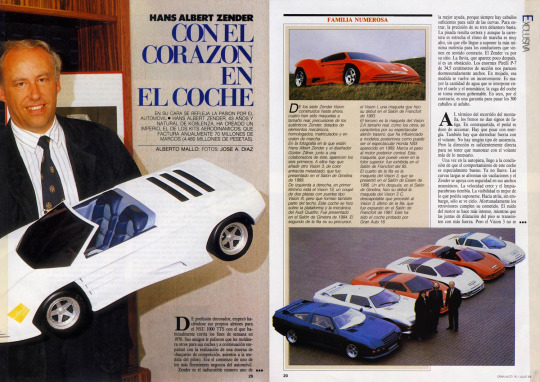
Zender (above) originally began producing bucket seats; he later branched out to the production of various bodyparts for cars like Fender flares and other such things made of fiber-reinforced plastics. He later branched out to a dealership business named H. A. Zender Exklusiv-Auto.
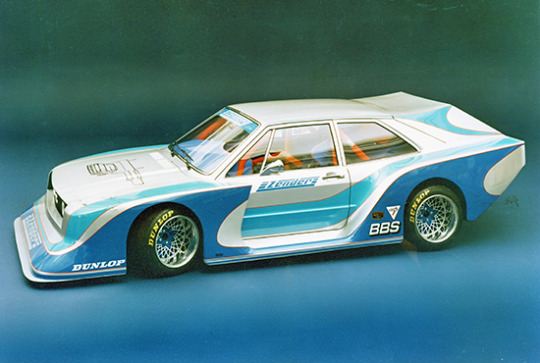
Zender would later produce parts for race cars such as the Volkswagen Scirocco Group 5, making fender flares and front and rear spoilers for the Sciroccos out of fiber-reinforced plastics. But Zender long dreamed of manufacturing his own cars to the world, and so he decided to experiment with the use of carbon fiber parts for both the body and chassis to make his own car. The first car he came up with? The Vision1.
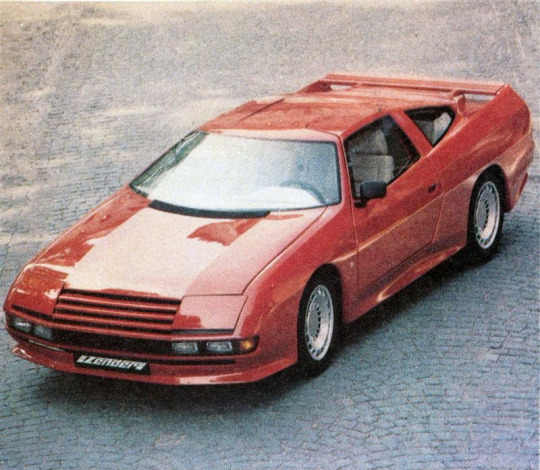
Presented at the 1983 Frankfurt Motor Show (this will become a recurring trend), the Vision1 was a stunning car for the time, featuring swooping lines and futuristic elements for the time, such as butterfly doors and full all-wheel drive with manual locking differentials.
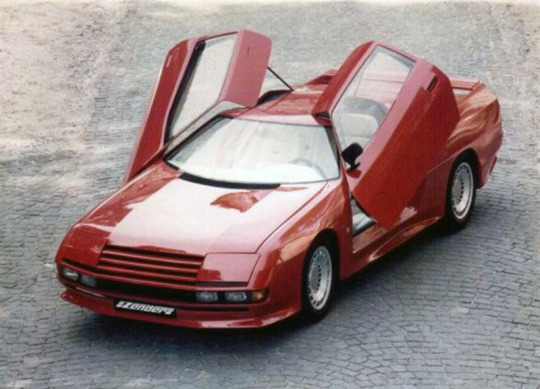
Using an Audi Quattro as a base, the Vision1 took both the 2.1L inline-5 engine and the chassis to make a futuristic supercar. The engine produced 300 horsepower and could do 270 km/h (168 mph). I believe only one was produced. Of course, Zender wanted to push for having his car enter production, and so he developed the Vision1 further... into the Vision1S.
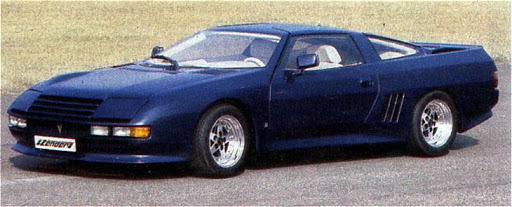
Presented at the 1984 Frankfurt Auto Show, the Vision1S was a development of the Vision1. While it did use the same chassis and engine from an Audi Quattro, the Vision1S did feature some stylistic changes and a modified engine; this time, the engine featured a different camshaft and different intake and exhaust manifolds, allowing it to produce 340 horsepower. The car also retained the same scissor door setup. It appears at least two Vision1Ses were produced.
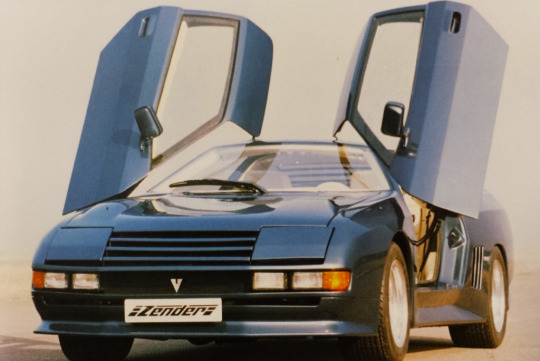
Ever wanting to advance his concepts further, Zender decided to build another prototype to showcase at the next edition of the Frankfurt Motor Show. What he came up with was appropriately called the Vision2.
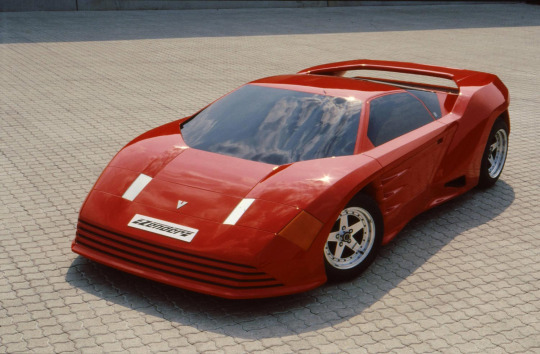
Presented at the 1985 Frankfurt Motor Show, the Vision2 was created with the sole intention of seeing the effectiveness of using the underbody of the car as a diffuser. As such, this car was strictly a shell car; it had no interior, and most importantly, no engine. While it is disappointing that this car could not run, I must say that the design of the rear of this thing is mad. Only one was produced.
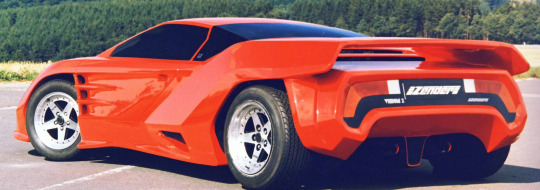
A convertible version of the car was also produced, but this was not a full-sized car, but rather, a smaller-scale model. This model never received a name as far as I’m aware, but a website calls it the Vision2c, so we’ll go with that.
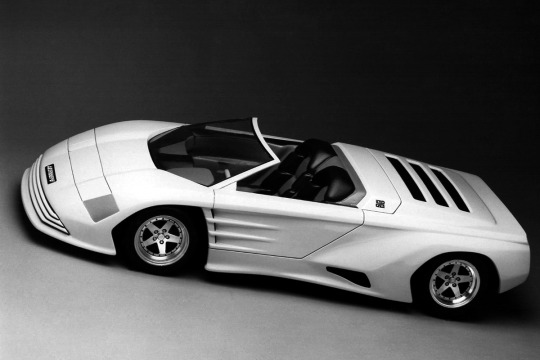
Of course, Zender wanted to bring his concept even further, designing a new car to take the underbody diffuser concept further. What did this lead to? The Vision3c.
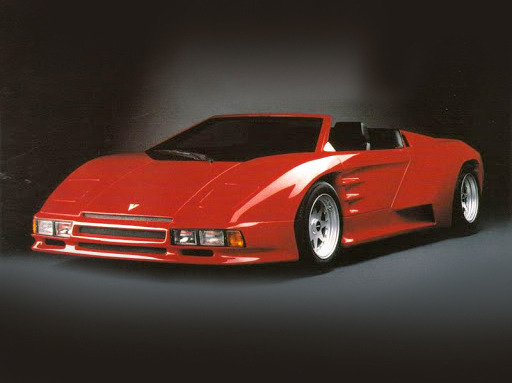
Presented at the 1986 Geneva Motor Show, the Vision3c was intended to be a continuation of the underbody diffuser development as seen on the Vision2. While it did have an interior, the car, just like the Vision2, was non-functional. As usual, only one was ever built.
As usual, Zender wanted to refine his design further, and employed the help of designer Günther Zillner to aid in this venture. To do this, they based their next car on the Vision3c and decided to make it a fully functional car. What came out of this was appropriately named the Vision3, which was presented at the 1987 Frankfurt Motor Show.
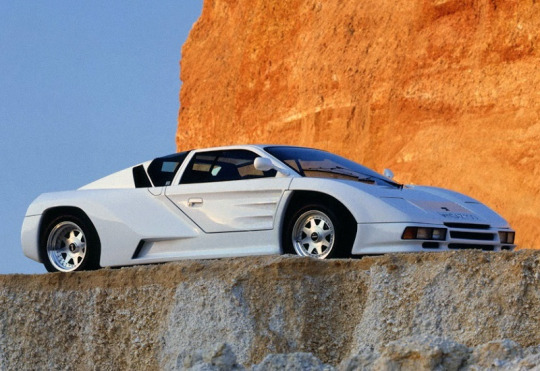
Unlike the previous two cars, the Vision2 and the Vision3c, the Vision3 was fully functional, featuring a Mercedes-Benz 5.6L M117 V8 engine sourced from a Mercedes-Benz 560 SEL. It produced about 300 horsepower and the car was capable of doing 270 km/h (168 mph).
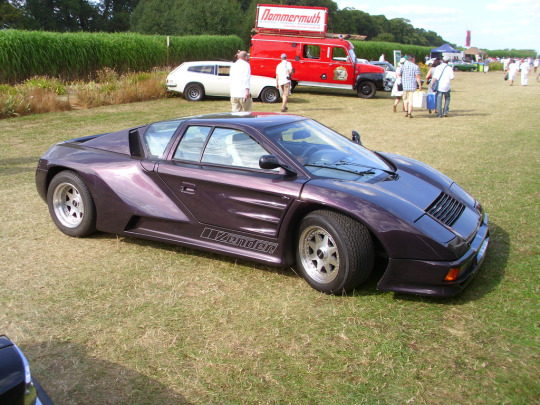
Also unlike the other cars, there appears to have been three or four Vision3s produced; one of the most famous ones is purple and registered with a German license plate reading “TR ZE 11”. Whether it has been sold to a private owner is unclear to me, although it appears like the car is still under the ownership of Zender. All of the Vision3 prototypes also look slightly different, with some featuring elements other don’t have like louvers on the hood. Unlike previous Zender cars, however, the Vision3 featured scissor doors.
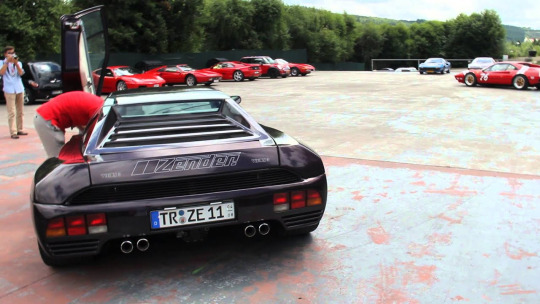
Of course, Zender himself is still trying to push to get his car into production. With the continued help of Zillner, Zender designed yet another car; this one would turn out to be arguably his most well-known one yet, helped by the fact that a Hot Wheels model was made of it.
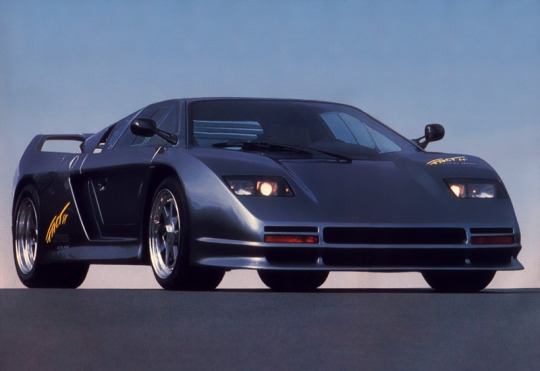
This, of course, was the Fact4 BiTurbo, which was presented at the 1989 Frankfurt Motor Show.
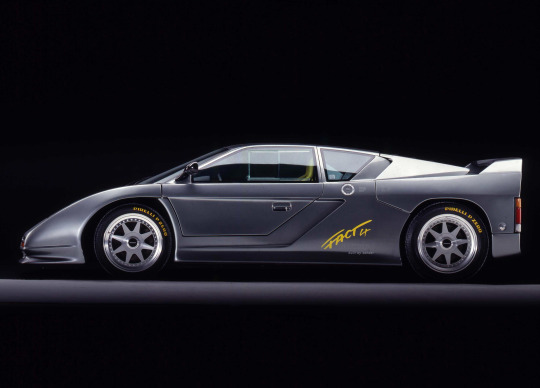
Notable as being the first car with a full-carbon fiber monocoque, the Fact4 BiTurbo sported a crisp silver paintjob, scissor doors and Pirelli P-Zero tires (the same brand as used on modern Formula One cars). The Fact4 BiTurbo had lines somewhat reminiscent of a Ferrari F40 and caused quite a stir.
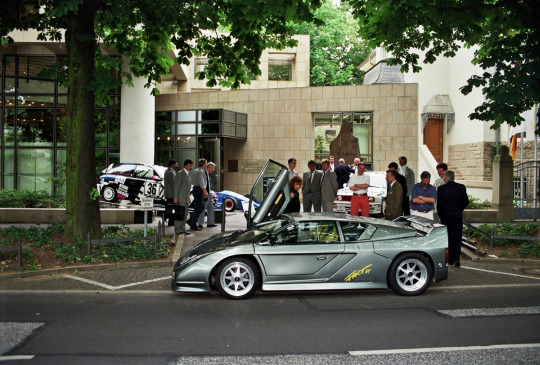
Featuring a Audi 3.6L V8 taken from an Audi V8 (yes, that was the name of the car) fitted with twin turbochargers, the Fact4 BiTurbo produced 440 horsepower and could do about 305 km/h (190 mph). The entire carbon fiber monocoque only weighed 55 kilograms (121 lb)! He attempted to put this into production, but production never came to be; only one was built.
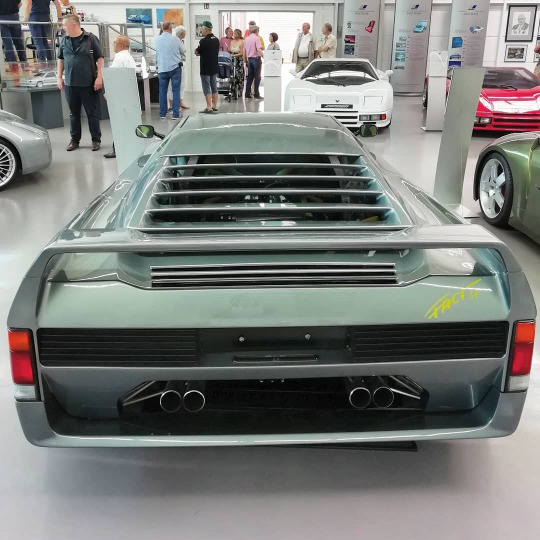
Zender would later expand upon this concept with the Fact4 Spider.
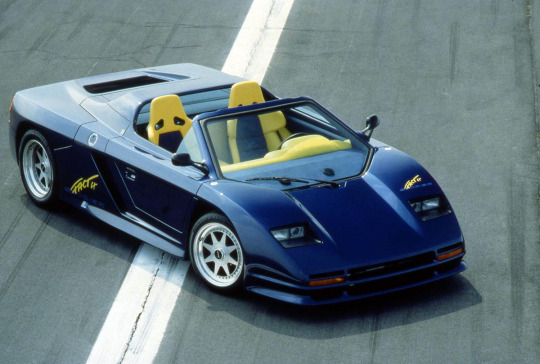
Originally presented at the 1991 Frankfurt Motor Show, the Fact4 Spider wowed the crowds with its 3 kilogram (6.62 lb) doors which, as usual, swung upwards. The car features some stylistic changes from the original Fact4 BiTurbo, especially with regards to the rear.
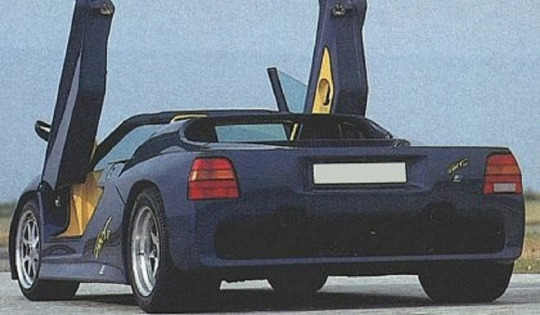
The Fact4 Spider was powered by the same 3.6L Audi V8 as the Fact4 BiTurbo, only this time, it wasn’t turbocharged. The engine produced 247 horsepower. In 1992, a second version of the Fact4 Spider was released, this time, with a curved hardtop. This version was presented at the 1992 Geneva Motor Show.
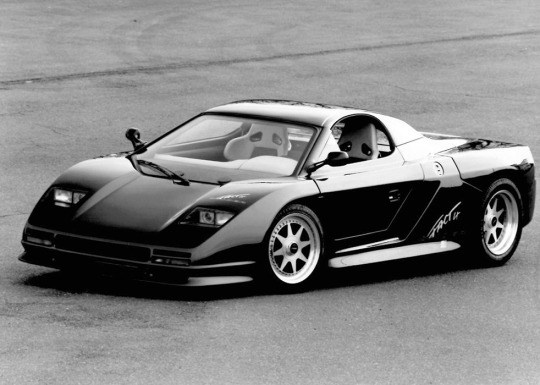
After the Fact4 family was designed, Zender would go on to design four more concept cars: the Progetto Cinque (lit. “Project 5”), the Escape6, the Thirty7 (stylized as “307”) and the Straight8. The first of those designs was the Progetto Cinque.
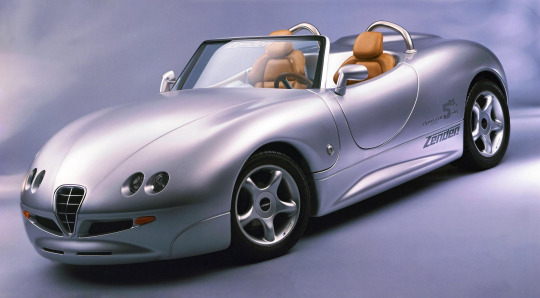
The Progetto Cinque was designed for Alfa Romeo; Zender had just approached them as a tuning partner and wanted to show them what he could do. Using an Alfa Romeo Type 916 Spider as a base, he fitted the car with the 3.0L V6 producing 189 horsepower. Alfa’s chief designer Walter de Silva actually came down to Zender’s base to inspect the car himself, and thus began “a long and successful partnership”, as described by Zender. The car was also presented at the 1995 Frankfurt Motor Show.
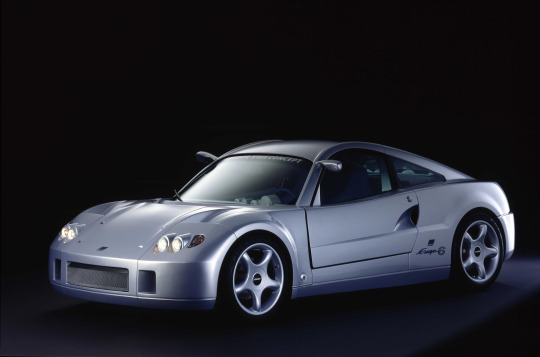
Away from the convertibles that Zender was designing was a small, nimble, lightweight coupe known as the Escape6. Presented at the 1997 Frankfurt Motor Show, the Escape6 was a highly lightweight coupe weighing only 850 kilograms (1874 lb). Using a Lotus Elise for a chassis, the car was fitted with a Volkswagen Group VR6 3.0L V6 producing 173 horsepower. The car featured, as usual, a composite body on a tubeframe chassis.
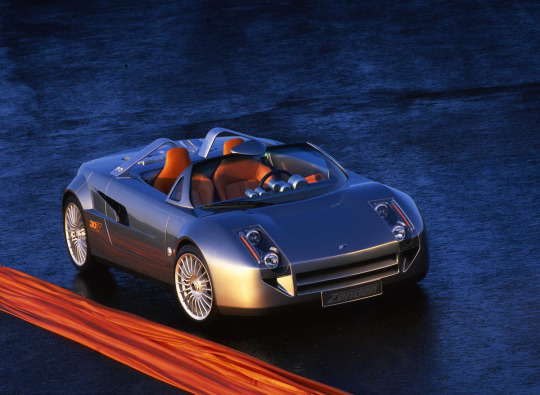
Zender’s thirtieth anniversary was fast approaching, and so, he wanted to design a car that would commemorate that event. He then designed the Thirty7, named as such because it was the 30th anniversary of the company and it was their 7th concept car design. Still using a Lotus Elise chassis as a base, the Thirty7 this time used a Volkswagen Group R4 1.8L engine producing 237 horsepower. It was first shown off at the 1999 Frankfurt Motor Show, but also went to other shows as well afterwards.
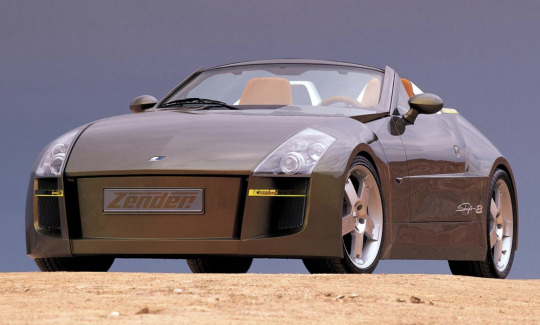
The last concept car Zender would design was another convertible known as the Straight8. Taking a practically unmodified BMW Z3 M as the base, the Straight8 had a custom tubeframe body made of composites fitted around it. The engine, a BMW S54B32 3.2L inline-6 producing 317 horsepower, was retained. The car itself also had a TVR ChromaFlair-esque paint called “Vert Soleil”, which could change its colors based on the lightning of the area. The car was first presented at the 2001... guess where.
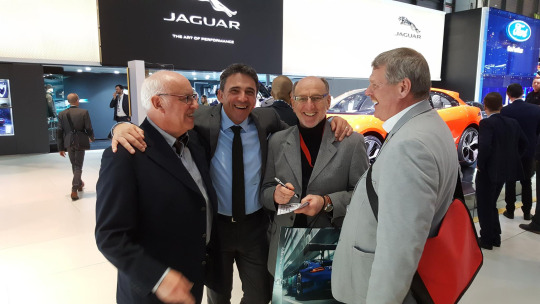
After the design of the Straight8, Zender went back to solely tuning cars, and shut up its German operations on 1 September 2008; the dealership apparently continues to exist to this day. Some time later though, Zender apparently was spun off into a separate business deal based in Caorle, Italy; Hans-Albert Zender does not appear to have any involvement with any of the company’s management, as it is now run by Marco Dei Vecchi and now tunes Italian automobiles like Alfa Romeos and Fiats. However, it appears Zender is still in cahoots with Dei Vecchi, as it seems like he has given his blessing to the running of the Italian operation, as seen in the above photograph where Zender (left) is meeting and presumably talking to Dei Vecchi (second from left) at the 2017 Geneva Motor Show.
Okay, now that I’ve gotten all the history of Zender out of the way, let’s actually get to what you came for: the actual casting.
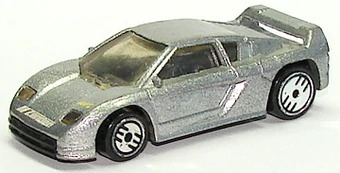
The Fact4 casting was designed by Larry Wood and introduced in 1991, at a time when forgotten concept cars were being produced by Hot Wheels, such as the IAD Alien and the soon-to-arrive Vector WX-3.

The rear of the Fact4 features some decent detail, mimicking the actual car... sort of. Also notable was the inclusion of side view mirrors, a relative rarity, even nowadays.

The base features few markings apart from the logo and copyright information. I can honestly see people not being able to identify this car, but this was at a time where little other information other than copyright and the Hot Wheels logo was placed on the base; this lasted from about the mid-’80s to the mid-to-late-’90s, at which point it was presumably mandated to put the name of the casting on the base unless it couldn’t fit.

For a casting of its time, the Fact4 has had a ludicrously long life, spanning eighteen years from 1991 to 2009, where it was last seen as one of the Birthday Cars in this paintscheme. Presumably forgotten concept cars like these were truly starting to get forgotten.

Now that I’ve gotten everything out of the way, I hope you, the reader, are a bit more informed about the Zender Fact4 BiTurbo and the history of the company as a whole. This was a fun article to write, and even though my original draft was wiped out via a stupid Tumblr glitch, I’d write something like this again any day.
- Grunty
0 notes
Photo

I was going to make fun of that couple from this 1967 SEAT 850 Coupe brochure because theyre lookin - I was going to make fun of that couple from this 1967 SEAT 850 Coupe brochure because theyre looking into that trunk like theres a newborn baby in there but then I really looked at that trunk and realized holy shit that is one well-packed trunk! Its perfect! Not a cubic whatever of wasted space! Make room señor Read more... ... From Jalopnik.com (@iamspeedrunner)... Repin by (@iamspeedrunner... by @iamspeedrunner. Also, check out https://www.iamspeedrunner.com
0 notes